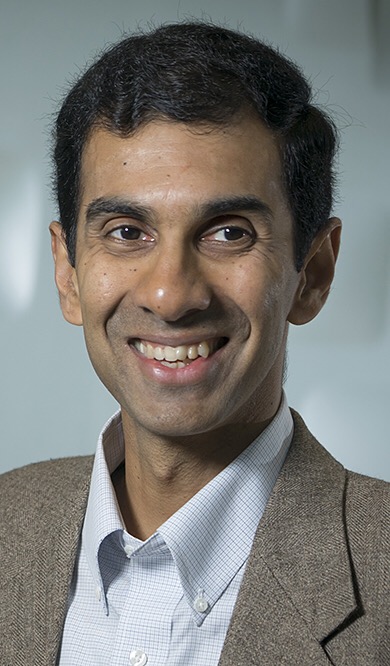Raghunathan unravels how the brain works, with applications to supercomputing

Purdue University professor Anand Raghunathan is spending the year at a new brain research center in India to explore the interface between neuroscience and engineering to learn more about how the brain works, and how this knowledge can be applied to improve supercomputer systems. The findings could help drive technological advances and the creation of new engineering tools to study the brain.
In 2011, "Watson," an artificially intelligent supercomputer system, made headlines when it won the American TV game show "Jeopardy." "While that was an amazing achievement, what many people didn't realize is that behind Watson was a cluster of supercomputer servers, which probably consumed over 20,000 watts," Raghunathan said. "The human brain consumes around 20 watts, and can perform several complex tasks; such efficiency has so far proven elusive to replicate in computers."
Raghunathan, a professor of electrical and computer engineering at Purdue in West Lafayette, Indiana, is one of three visiting distinguished chairs in the Center for Computational Brain Research (CCBR) at the Indian Institute of Technology (IIT) Madras. He is working with neuroscientists, and fellow CCBR chairs, professor Mriganka Sur of Massachusetts Institute of Technology and Partha Mitra of Cold Spring Harbor Lab, to examine how knowledge of the brain's structure and neural circuitry might be applied to enhance supercomputer hardware and software architectures; improve supercomputer speed and energy efficiency; develop next-generation algorithms, software and hardware for machine intelligence; and improve the robustness and programmability of software systems.
The team aims to leverage modern supercomputing tools and techniques to better analyze the structure and activity of neural circuits, including examining big data sets related to whole-brain measurements of neuronal connectivity and activity; the development of new technologies for data acquisition; and the theoretical understanding of these data to derive underlying principles.
The distinguished chairs were launched at IIT Madras through a gift from IIT Madras alumnus and Infosys co-founder Kris Gopalakrishnan.
"The Center for Computational Brain Research at IIT Madras is a perfect example of how alumni relations and international collaborations can be synergized for maximum effect," said professor R. Nagarajan, dean for international and alumni relations at IIT Madras. "During a visit to campus in 2014, Purdue President Mitch Daniels signed an agreement with IIT Madras, which has facilitated such collaborative engagements. We are excited about the center, and its potential for opening up an area of cutting-edge research with significant global relevance."
"We are in the early stages," Raghunathan said. "While the three chairs are already working with over a dozen IIT Madras students and faculty, we realize that the scale of the problem is large. We hope to leverage and contribute to the emerging global research community in computational brain research and to raise additional private- and public-sector support to expand the scale of our activities."
Suresh Garimella, Purdue's executive vice president for research and partnerships and Goodson Distinguished Professor of Mechanical Engineering, said, "The Center for Computational Brain Research is a great example of today's interdisciplinary research ecosystem, with scientists from diverse disciplines combining knowledge to tackle complex global questions. Such university partnerships, with faculty from IIT Madras, Purdue and other institutions joining together to pursue a common goal, represent true bilateral cooperation between the United States and India."
IIT Madras is among the foremost institutes of higher technological education and basic and applied research. Founded in 1959, IIT Madras is a residential institute with nearly 550 faculty, 8,000 students and 1,250 administrative and supporting staff. It has established itself as a premier center for teaching, research and industrial consultancy in India. IIT Madras has 16 academic departments and advanced research centers in various disciplines of engineering and pure sciences, with nearly 100 laboratories. The campus is located in the city of Chennai, previously known as Madras. https://www.iitm.ac.in/
Purdue University, a top U.S. public research institution, and the No. 1 choice for international students in STEM fields, has been engaged in deep and impactful partnerships overseas for many decades as part of its land-grant mission. Committed to affordability, the university has frozen tuition and most fees at 2012-13 levels. Purdue is changing the student experience with greater focus on faculty-student interaction and creative use of technology. As a major global research institution focused on fundamental research excellence coupled with translation to practice, Purdue is pioneering new pathways for faculty and student innovators who have a vision for moving the world forward. www.purdue.edu
Raghunathan directs the Integrated Systems Laboratory in the School of Electrical and supercomputer Engineering at Purdue. His group's research spans various topics in very-large-scale-integration (VLSI) and supercomputer engineering. Before joining Purdue, he was a senior researcher at NEC Laboratories America and held a visiting position in the Department of Electrical Engineering at Princeton University.

 How to resolve AdBlock issue?
How to resolve AdBlock issue?